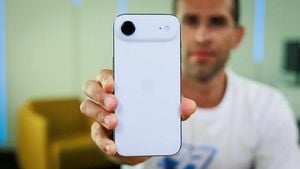Move over, Wordle and Connections—the New York Times’ latest word game, Strands, is quickly cementing its place as a daily must-play for puzzle enthusiasts. On October 11, 2025, Strands delivered a fresh challenge to solvers with a theme that was both clever and visually striking: “That’s branding.” For those who love a twist on the classic word search, this puzzle invited players to flex their pop culture knowledge, pattern recognition, and strategic thinking in one engaging package.
Strands, as reported by multiple outlets including Mashable, The Economic Times, and CNET, is not your average word search. The game takes place on a 6x8 grid, where every single letter is part of a solution. Players can connect adjacent letters in any direction—up, down, left, right, or even diagonally. The catch? Words can twist and turn, forming quirky shapes and patterns across the board. There’s no overlap between theme words, and the entire grid is filled once the puzzle is solved. This makes for a brain-teasing experience that rewards careful observation and lateral thinking.
Each day’s Strands puzzle features a central theme, and on October 11, the theme was “That’s branding.” According to Parade, the general hint for the day was “Recognizable visual identity,” while CNET offered an additional clue: “Company images.” These hints nudged players to think about graphics or symbols that are synonymous with major brands—those logos you could recognize in your sleep or spot from a mile away.
At the heart of every Strands puzzle is the “spangram,” a longer word or phrase that encapsulates the day’s theme. This spangram stretches across the grid, either horizontally or vertically, and acts as a major thematic anchor. For the October 11 puzzle, the spangram was “ICONIC LOGOS,” and it ran vertically through the grid. This phrase, once discovered, made it much easier for players to identify the shorter theme words scattered throughout the board.
So, what were the answers that fit the “That’s branding” theme? As detailed by Mashable, The Economic Times, Parade, and CNET, the word list for October 11 included:
- PEACOCK (the colorful NBC logo)
- SHELL (the seashell emblem of Shell)
- BULLSEYE (the circular Target logo)
- SWOOSH (Nike’s famous checkmark)
- APPLE (the partially bitten fruit that represents Apple Inc.)
- ARCHES (the golden arches of McDonald’s)
- ICONIC LOGOS (the spangram)
Each of these words conjures up a vivid image in the minds of millions—proof of the power and ubiquity of brand logos in modern culture. As The Economic Times explained, “Familiarity with global brand imagery will speed up solutions considerably.” The puzzle was rated a 2 out of 5 on the difficulty scale, making it accessible to most players, especially those with a knack for recognizing famous symbols.
How does Strands work, exactly? According to Parade and CNET, the game’s rules are straightforward, but the challenge lies in execution. Players must find all the theme words, which remain highlighted in blue when discovered. The spangram, once found, is highlighted in yellow. To submit a word, you drag or tap the letters in sequence—double-tapping the last letter if needed. If you’re stuck, you can find non-theme words of four letters or more to earn hints. For every three such words, the game reveals one letter of a theme word, or shows its letter order if a hint is already active. All letters in the grid are used by the time the puzzle is solved, and no theme words overlap.
Strategic tips abound for those looking to up their Strands game. The Economic Times suggests hunting for the spangram early, as it provides a thematic anchor that makes the rest of the puzzle easier. Starting at the grid’s corners can also be helpful, since many theme words are placed near the edges. And, as CNET notes, thinking broadly about brand nicknames or non-literal descriptors can help when a direct approach stalls.
October 11’s puzzle offered a few specific hints to nudge players in the right direction. For example, “circular target board where you need to hit the centre” pointed to BULLSEYE, while “company name with a partially bitten fruit” led players to APPLE. The first two letters of each theme word were also provided as a bonus hint: PE (Peacock), AR (Arches), AP (Apple), SH (Shell), SW (Swoosh), BU (Bullseye), and IC (Iconic Logos).
What makes Strands stand out from other NYT games like Wordle, Connections, or the Mini Crossword? For starters, its emphasis on themes and the unique spangram mechanic sets it apart. As Mashable put it, Strands “creates a brain-teasing game that takes a little longer to play than its other games, like Wordle and Connections.” The requirement that every letter in the grid is used in a theme word, and the way words can twist and turn, means each puzzle feels fresh and unpredictable. There’s also a strong element of pop culture and general knowledge, as themes often draw from widely recognized topics.
For those who found the October 11 puzzle a breeze, there are plenty of ways to keep the challenge alive. CNET regularly highlights the toughest recent Strands puzzles, such as “Dated slang” or “Thar she blows!”—topics that require specialized knowledge to crack. But for most players, the “That’s branding” theme was an enjoyable and accessible entry point, leveraging the universal language of logos that permeate daily life.
Strands is available on the New York Times Games website and through the NYT Games app, with a subscription required for full access. As the game continues to grow in popularity, it’s clear that its blend of strategy, pattern recognition, and thematic play is resonating with a broad audience. Whether you’re a die-hard word game fan or just looking for a new brain teaser to add to your daily routine, Strands offers a satisfying and visually engaging experience—one iconic logo at a time.







